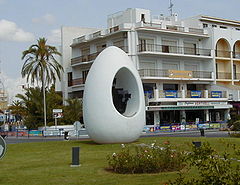- Egg of Columbus
-
Coordinates: 38°58′48″N 1°18′22″E / 38.979870°N 1.306033°E
An egg of Columbus or Columbus's egg refers to a brilliant idea or discovery that seems simple or easy after the fact. The expression refers to a popular story of how Christopher Columbus, having been told that discovering the Americas was no great accomplishment, challenged his critics to make an egg stand on its tip. After his challengers gave up, Columbus did it himself by tapping the egg on the table so as to flatten its tip.
The story is often alluded to when discussing creativity.[1] The term has also been used as the trade name of puzzles.[citation needed]
Contents
Source of the story
The Columbus story may have originated with Italian historian and traveler Girolamo Benzoni. In his book History of the New World, published in 1565,[2] he wrote:
Columbus was dining with many Spanish nobles when one of them said: 'Sir Christopher, even if your lordship had not discovered the Indies, there would have been, here in Spain which is a country abundant with great men knowledgeable in cosmography and literature, one who would have started a similar adventure with the same result.' Columbus did not respond to these words but asked for a whole egg to be brought to him. He placed it on the table and said: 'My lords, I will lay a wager with any of you that you are unable to make this egg stand on its end like I will do without any kind of help or aid.' They all tried without success and when the egg returned to Columbus, he tapped it gently on the table breaking it slightly and, with this, the egg stood on its end. All those present were confounded and understood what he meant: that once the feat has been done, anyone knows how to do it.
The factual accuracy of this story is called into question by its similarity to another tale published fifteen years earlier (while Benzoni was still traveling in the Americas) by painter and architect Giorgio Vasari.[3] According to Vasari, the young Italian architect Filippo Brunelleschi had designed an unusually large and heavy dome for Santa Maria del Fiore, the cathedral (Duomo) in Florence, Italy. City officials had asked to see his model, but he refused, proposing instead:
That whosoever could make an egg stand upright on a flat piece of marble should build the cupola, since thus each man's intellect would be discerned. Taking an egg, therefore, all those Masters sought to make it stand upright, but not one could find a way. Whereupon Filippo, being told to make it stand, took it graciously, and, giving one end of it a blow on the flat piece of marble, made it stand upright. The craftsmen protested that they could have done the same; but Filippo answered, laughing, that they could also have raised the cupola, if they had seen the model or the design. And so it was resolved that he should be commissioned to carry out this work.
When the church was finally built it had the shape of half an egg slightly flattened at the top.[4]
In popular culture
 Monument to the discovery of America by Columbus in the shape of an egg in Sant Antoni de Portmany, Ibiza, Spain
Monument to the discovery of America by Columbus in the shape of an egg in Sant Antoni de Portmany, Ibiza, Spain
- A version of the story is told by the song Don Christopher by Indie rock band Bishop Allen on their album November, though the song says that Christopher Columbus "lopped the tip right off the shell."
- The song, titled after the story, The Egg of Columbus is by The Extraordinaires, an Indie band out of Philadelphia, PA, and is featured on their album Electric and Benevolent.
- In the anime series of Lupin the Third film, The Columbus Files, the egg itself is a priceless artifact that was owned by Columbus.
- In the anime series Sora no Otoshimono, the event of Columbus and the balancing of the egg is alluded to.
- The narrator in The Great Gatsby by F. Scott Fitzgerald describes the islands of East Egg and West Egg saying, "They are not perfect ovals -- like the egg in the Columbus story, they are both crushed flat at the contact end..."
See also
- Egg of Li Chun, a Chinese egg-balancing tradition.
- Tesla's Egg of Columbus, a metal egg that stands on end in a rotating magnetic field.
- Columbus Breaking the Egg, an engraving by William Hogarth.
- Egg of Columbus (tangram puzzle).
- Egg of Columbus (mechanical puzzle).
- Superegg, an egg-like toy designed by Piet Hein that stands on its ends.
- Gordian Knot.
- Väinämöinen in Kalevala was asked to tie an egg into a knot, in which he succeeded.
References
- ^ Kant, Immanuel (1790), Critique of Judgement, Book II, "Analytic of the Sublime," s43, fn.1: "In my part of the country, if you set a common man a problem like that of Columbus and his egg, he says, 'There is no art in that, it is only science': ie you can do it if you know how; and he says just the same of all the would-be arts of jugglers."
- ^ Girolamo Benzoni (1565), Historia del Mondo Nuovo; Venice. English translation History of the New World by Girolamo Benzoni, Hakluyt Society, London, 1857.
- ^ Giorgio Vasari (1550), Lives of the Most Excellent Painters, Sculptors, and Architects. Florence.
- ^ Martin Gardner (May-June 1996). "The great egg-balancing mystery". Skeptical Inquirer 20 (3). Archived from the original on Apr 03, 2008. http://web.archive.org/web/20080403233401/http://findarticles.com/p/articles/mi_m2843/is_n3_v20/ai_18372128.
- Baldwin, James. "Columbus and the egg", 1903.
Categories:- Eggs in culture
- Christopher Columbus
- Italian folklore
Wikimedia Foundation. 2010.

